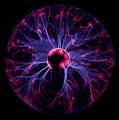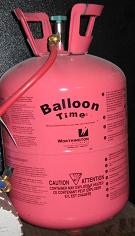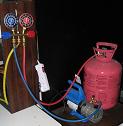|
Plasma Properties and Problems
A plasma is called the fourth state of matter (after solid liquid
and gas) and it is what makes the stars bright and fluorescent lamps
work. An electric field is used tear electrons off a gas molecule
and when they recombine the result is light. At low currents you
get a relatively gentle light like you see in an aurora borealis
or those novelty plasma globes. At higher currents and higher gas
pressures you transition to an "arc" like those you see in arc welding
or lightning.

The air you breathe is a relatively inert material
but in an plasma it creates charged oxygen and nitrogen ions that
are highly reactive. You can use air as a plasma medium but the
ions will rapidly corrode and etch any container. Even after the
plasma is turned off oxygen ions will combine with oxygen molecules
to form ozone which is a toxic gas even in low concentrations. For
my plasma experiments I needed a safe gas and that means one of
the inert gases: Helium (He), Neon (Ne), Argon (Ar), or Krypton
(Kr).
Noble Gas Supplies
There are easily obtainable industrial and scientific
supplies of noble gases. Krypton is used in light bulbs to protect
the filament and allow a brighter light. Argon is used extensively
in welding to keep air away from the arc column especially for easily
oxidized metals like aluminum. Neon is used in Neon signs and Helium
is used in party balloons.
All noble gases can be purchased from a scientific
supply house for about $200 a refill. The problem is you have to
buy a gas bottle for them to fill. A small lecture bottle (about
two feet long) or a big industrial argon bottle (about four feet
tall) with cost you about $200. A little expensive for a hobbyist
or poor starving inventor.
A Helium Bottle Comes with 30 Free Balloons
I decided to use helium and I found a much cheaper
solution. You can buy "Balloon Time" disposable bottles
of helium of about $35 and you get 30 free balloons with it. I originally
wanted to use neon or the neon/helium mix used in lasers because
I am familiar with those gases. It turns out helium has some properties
that make it a better choice for my project.


Remove the balloon filling nozzle (plastic bendy
thing) and you will find a standard automotive 1/4" flare connector.
Connect your helium source to the red side of the
manifold. The color coding is accidental but having the blue pump
on the blue line and the red gas bottle on the red line makes the
system look like it was designed by a professional.

Using Paschen's to Measure Gas Pressure
I will still have to use air as a plasma gas to calibrate
my Pirani gauge. Air and helium have different Paschen's Law curves
and I will use this difference to verify my calibration.
A little background on the Paschen Formula that will
be used to calibrate my Pirani gauge
(see my Vacuum Gauges page).
The breakdown voltage of a plasma depends on three
factors; the type of gas, the pressure of the gas, and the distance
between the electrodes. Measuring the breakdown voltage will give
you the pressure if you know width of the electrode gap and the
type of gas. See the "Measurements of the Breakdown Potentials
For Different Cathode Materials in The Townsend Discharge"
paper
for a lot data and practical information on measuring the Paschen effect.
There are lots of circuits for neon tube relaxation
oscillators available. It is just a neon bulb with a series resistor
and a parallel capacity. When you power the circuit the neon bulb
is off and capacitor has zero voltage. The resistor starts to charge
the capacitor in a classic sawtooth until the capacitor reaches
the breakdown voltage of the neon bulb. The capacitor then dumps
its charge into the neon gas until the voltage is too low to sustain
a plasma and the sawtooth starts again.
By constructing a relaxation oscillator I can measure
the peak voltage of the circuit which is the breakdown voltage of
the gas. By varying the gas pressure I can calibrate my Priani gauge.
Since the Priani gauge curve is smooth I can get very good calibration
with only a few data points. By using both air and helium I can
verify my calibration so I have an accurate measure of the gas
pressure in my vacuum chamber during later experiments.
|

